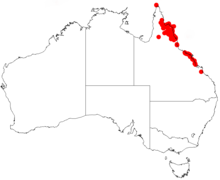| Acacia oraria | |
|---|---|
| Scientific classification | |
| Kingdom: | Plantae |
| Clade: | Tracheophytes |
| Clade: | Angiosperms |
| Clade: | Eudicots |
| Clade: | Rosids |
| Order: | Fabales |
| Family: | Fabaceae |
| Subfamily: | Caesalpinioideae |
| Clade: | Mimosoid clade |
| Genus: | Acacia |
| Species: | A. oraria
|
| Binomial name | |
| Acacia oraria | |

| |
| Occurrence in Australia data from AVH | |
Acacia oraria, also commonly known as coastal wattle,[1] is a shrub of the genus Acacia and the subgenus Plurinerves that is endemic to an area along the northeastern coast of Australia and on the islands of Flores[2] and Timor.[1]
Description[edit]
The tree typically has a height of 3 to 10 m (9.8 to 32.8 ft)[3] and a dbh of around 30 cm (12 in)[1] with a spreading habit with a canopy that can had widths of up to 6 m (20 ft).[4] It has fissured fibrous bark and white scurfy branchlets. Like most species of Acacia it has phyllodes rather than true leaves. The glabrous and evergreen phyllodes have an inequilaterally obovate-oblanceolate to elliptic shape with a length of about 5 to 8 cm (2.0 to 3.1 in) and a width of 1.5 to 3.5 cm (0.59 to 1.38 in) and have three or more distant main nerves. When it blooms it produces axillary inflorescences with spherical flower-heads that have a diameter of around 5 mm (0.20 in) and contain 30 to 45 cream to pale yellow coloured flowers.[3] Following flowering it produces scurfy, twisted or coiled seed pods that have a length of up to about 12 cm (4.7 in) and a width of 0.9 to 1.5 cm (0.35 to 0.59 in). The podds contain dull black seeds with a length of about 4 mm (0.16 in) and a width of around 3 mm (0.12 in) with a reddish coloured thickened funicle red or reddish that passes around the seed and then folds back on itself.[1]
Distribution[edit]
It is found in tropical areas of Australis and South East Asia including Flores in Indonesia and in Timor. It is found in areas close to the coast in Far North Queensland and north east Queensland in several disjunct populations. It is found from sea level to altitudes of about 500 m (1,600 ft) and is situated in a variety of habitats including beaches, in open forest and along creeks and water courses and less frequently on the margins of monsoon forest and dry rain forest.[1]
Taxonomy[edit]
The species was first formally described by the botanist Ferdinand von Mueller in 1879 as a part of the work Fragmenta Phytographiae Australiae. It was reclassified as Racosperma orarium by Leslie Pedley in 1986 then returned to genus Acacia in 2006.[5]
Uses[edit]
The tree is grown as a street tree or ornamental in Indonesia and is known to coppice quite well. It has a symbiotic relationship with some bacteria that form nodules on the roots and can fix nitrogen into the soil.[2] As for most species of Acacia the bark contains quantities of tannins and are astringent and can be used to treat diarrhoea and dysentery.[2]
See also[edit]
References[edit]
- ^ a b c d e F.A.Zich; B.P.M.Hyland; T.Whiffen; R.A.Kerrigan (2020). "Acacia oraria". Australian Tropical Rainforest Plants Edition 8 (RFK8). Centre for Australian National Biodiversity Research (CANBR), Australian Government. Retrieved 2 July 2021.
- ^ a b c Ken Fern (3 June 2019). "Acacia oraria F.Muell. Fabaceae". Useful Tropical Plants Database. Retrieved 25 December 2020.
- ^ a b "Acacia oraria". World Wide Wattle. Western Australian Herbarium. Retrieved 25 December 2020.
- ^ "Acacia oraria". Plantfinder. GardensOnline. Retrieved 26 December 2020.
- ^ "Acacia oraria F.Muell". Atlas of Living Australia. Global Biodiversity Information Facility. Retrieved 26 December 2020.